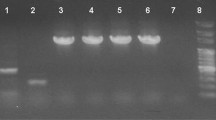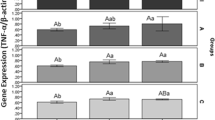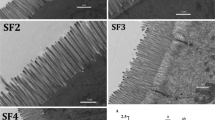Abstract
The present study histologically examined the effects of glucan-containing and Lactobacillus rhamnosus GG (LGG)-containing diets on intestinal damages inflicted on Nile tilapia by Aeromonas challenges. Tilapia were fed control, glucan, and LGG diets for 2 weeks and were subsequently challenged with Aeromonas. The intestines were then histologically examined at 1, 7, 14, and 21 days post-infection. Mortality following the challenge was lower for the fish fed the glucan and LGG diets. The intestines of these groups also showed increased inflammatory cell infiltration and reduced intestinal damage from Aeromonas. Moreover, inflammatory cell infiltration occurred more rapidly in the glucan-fed than in the LGG-fed fish following the challenge. Before the challenge, the dominant mucous cell was the acid type in all the tests. After the challenge, the main mucus cell type in the proximal intestine of the glucan-fed fish shifted to AB-PAS double-staining cells, while in the LGG-fed fish, it remained the acid type throughout the test period, and the number of double-staining cells was smaller than in the control fish after the challenge. Thus, the different mucous cell and inflammatory cell responses show that glucan and LGG might have different immunostimulative effects, although they both reduced the intestinal damage following Aeromonas challenges.






Similar content being viewed by others
References
Cahill MM (1990) Virulence factors in motile Aeromonas species. J Appl Bacteriol 69:1–16
Bricknell I, Dalmo RA (2005) The use of immunostimulants in fish larval aquaculture. Fish Shellfish Immunol 19:457–472
Anderson DP (1992) Immunostimulants, adjuvants, and vaccine carriers in fish: applications to aquaculture. Annu Rev Fish Dis 2:281–307
Sakai M (1999) Current research status of fish immunostimulants. Aquaculture 172:63–92
Dalmo RA, Bøgwald J (2008) β-glucans as conductors of immune symphonies. Fish Shellfish Immunol 25:384–396
Kumari J, Sahoo PK (2006) Dietary β-1,3 glucan potentiates innate immunity and disease resistance of Asian catfish Clarias batrachus (L.). J Fish Dis 29:95–101
Ortuno J, Cuesta A, Rodríguez A, Esteban MA, Mesegure J (2002) Oral administration of yeast, Saccharomyces cerevisiae, enhances the cellular innate immune response of gilthead seabream (Sparus aurata L.). Vet Immunol Immunopathol 85:41–50
Robertsen B (1999) Modulation of the non-specific defence of fish by structurally conserved microbial polymers. Fish Shellfish Immunol 9:269–290
Selvaraj V, Sampath K, Sekar V (2005) Administration of yeast glucan enhances survival and some non-specific and specific immune parameters in carp (Cyprinus carpio) infected with Aeromonas hydrophila. Fish Shellfish Immunol 19:293–306
Bridle AR, Carter CG, Morrison RN, Nowak BF (2005) The effect of β-glucan administration on macrophage respiratory burst activity and Atlantic salmon Salmo salar L., challenged with amoebic gill disease–evidence of inherent resistance. J Fish Dis 28:347–356
Ai Q, Mai K, Zhang L, Tan B, Zhang W, Xu W, Li H (2007) Effects of dietary β-1,3 glucan on innate immune response of large yellow croaker, Pseudosciaena crocea. Fish Shellfish Immunol 22:394–402
Irianto A, Austin B (2002) Probiotics in aquaculture. J Fish Dis 25:633–642
Anuradha S, Rajeshwari K (2005) Probiotics in health and disease. J Indian Acad Clin Med 6(1):67–72
Bols NC, Brubacher JL, Ganassin RC, Lee LEJ (2001) Ecotoxicology and innate immunity in fish. Dev Comp Immunol 25:853–873
Ellis AE (2001) Innate host defense mechanisms of fish against viruses and bacteria. Dev Comp Immunol 25:827–839
Subramanian S, MacKinnon SL, Ross NW (2007) A comparative study on innate immune parameters in the epidermal mucus of various fish species. Comp Biochem Physiol Part B 148:256–263
Shimizu T, Hirano H, Shimizu S, Kishioka C, Sakakura Y, Majima Y (2001) Differential properties of mucous glycoproteins in rat nasal epithelium: a comparison between allergic inflammation and lipopolysaccharide stimulation. Am J Respir Crit Care Med 164:1077–1082
Theodoropoulos G, Carraway KL (2007) Molecular signaling in the regulation of mucins. J Cell Biochem 102:1103–1116
Wu YM, Nowack DD, Omenn GS, Haab BB (2009) Mucin glycosylation is altered by pro-inflammatory signaling in pancreatic-cancer cells. J Proteome Res 8:1876–1886
Humason GL (1972) Animal tissue techniques, 3rd edn. W.H Freeman, San Francisco
Sabóia-Moraes SMT, Hernandez-Blazquez FJ, Mota DL, Bittencourt AM (1996) Mucous cell types in the branchial epithelium of the euryhaline fish Poecilia vivipara. J Fish Biol 49:545–548
Han HJ (2006) Characterization of virulence related genes of motile Aeromonas. PhD dissertation, Tokyo University of Marine Science and Technology, Tokyo
Manjili MH, France MP, Sangster NC, Rothwell TLW (1998) Quantitative and qualitative changes in intestinal goblet cells during primary infection of Trichostrongylus colubriformis high and low responder guinea pigs. Int J Parasitol 28:761–765
Balcázar JL, de Blas I, Ruiz-Zarzuela I, Vendrell D, Gironés O, Muzquiz JL (2007) Enhancement of the immune response and protection induced by probiotic lactic acid bacteria against furunculosis in rainbow trout (Oncorhynchus mykiss). FEMS Immunol Med Microbiol 51:185–193
Matsuzaki T, Chin J (2000) Modulating immune responses with probiotic bacteria. Immunol Cell Biol 78:67–73
Acknowledgments
This work was supported in part by the Japan Society for the Promotion of Science (JSPS) Asian CORE Program and by a Grant-in-Aid from the JSPS (20580199).
Author information
Authors and Affiliations
Corresponding author
Rights and permissions
About this article
Cite this article
Ngamkala, S., Futami, K., Endo, M. et al. Immunological effects of glucan and Lactobacillus rhamnosus GG, a probiotic bacterium, on Nile tilapia Oreochromis niloticus intestine with oral Aeromonas challenges. Fish Sci 76, 833–840 (2010). https://doi.org/10.1007/s12562-010-0280-0
Received:
Accepted:
Published:
Issue Date:
DOI: https://doi.org/10.1007/s12562-010-0280-0




